From a distant land, Kyrgyzstan, Michele, visits the Kumbh Mela, virtually, at Prayagraj. She finds oneness and unity in millions in the Hindu festival and finds parallels in the water festivals around the world. A Different Truths exclusive.
Today marks the start of the final weeks of the current Kumbh Mela, Festival of the Sacred Pitcher, a 55 to 60-day period on a 12-year turning of the Hindu calendar, a 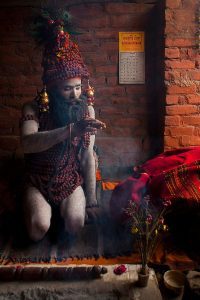 holy time of cleansing and reinvigoration to purpose, to life, at one of four sacred sites. It is simultaneously a vibrantly contemporary, and an ancient ceremony, steeped in the hopes and traditions of the Hindu faith — a unique time, where the royal and renown may rub elbows with the unshackled reverence of ascetic Naga sadhus (saints), clad only in cinder ashes and their faith.
holy time of cleansing and reinvigoration to purpose, to life, at one of four sacred sites. It is simultaneously a vibrantly contemporary, and an ancient ceremony, steeped in the hopes and traditions of the Hindu faith — a unique time, where the royal and renown may rub elbows with the unshackled reverence of ascetic Naga sadhus (saints), clad only in cinder ashes and their faith.
With auspicious dates calculated by particular alignments of the Sun, the Moon, and Jupiter, the city of Prayagraj is host to this year’s iteration of the mystical Kumbh Mela, taking place between January 14 and March 4, 2019. An estimated 15 crore, or 150,000,000 (one hundred and fifty million) people are expected to attend Kumbh Mela 2019. Inscribed in 2017 on the Representative List of the Intangible Cultural Heritage of Humanity,[1] the event is touted as “the largest peaceful congregation of pilgrims on earth” by UNESCO.
Viewed from above, the banks of the rivers Ganga, Yamuna and mythical Saraswati become the beating heart in a living recreation of the human drama of man, gods and demons, earthly realities and spiritual cleansing. Throngs flow, like blood in the arteries of humanity, from shore to water, speaking the tongues of their families and forebears, bearing the sins of generations past and future, to be washed by the hopes of a faith, and belief in the nectar of immortality.
Viewed from above, the banks of the rivers Ganga, Yamuna and mythical Saraswati become the beating heart in a living recreation of the human drama of man, gods and demons, earthly realities and spiritual cleansing.
Erected on riverbanks newly-scoured by the recent monsoon rains and floods, the tent-city hosting the millions of pilgrims is bathed in a wash of footfall dust, campfire smoke and river fogs. At night, the air greys into a glittering, undulating network of lights, punctuated by flags and the pulse of song, wafting over the unsleeping chorus of humanity sheltering within the enclave.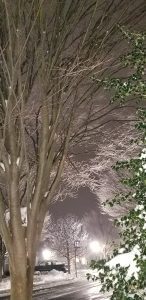
Recently, February 19th, was the largest supermoon of 2019, a time skies are tinged with mysteries ancient and scarce-remembered, when tides rise, when the Moon pulls closely to the Earth, painting her silvered bridge over all below.
I wish I could have seen the bridge of the Moon, reflected in the confluence of the three historic rivers, during Kumbh Mela this year.
Instead, I sit, typing, looking out at a world made small by the millions and billions of tiny, perfect snowflakes, falling, inches-each-hour, in a blizzard. I see some white-blanketed fir trees nearby, and not much past them. No birds, no squirrels brave the snow, seeking food or camaraderie. All is silent, waiting for that lifting of wind and clouds and slashing white, when people will emerge from homes to play in the snow, or begin the heavy labor of shoveling it from walkways and driveways, plowing it from roadways, when birds and animals venture out to verify that their favorite places might be snow-covered, but have not disappeared.
A far cry from the warmer shores where hundreds of millions of souls are thronging at this historic Kumbh Mela, the first in the city since its name was changed from Allahabad. I am not Hindu, I am not Indian, though my family is a melting pot, and we have relatives, married into our family, over time, from India and from many lands and cultures, over generations past and present.
Looking at pictures online, chatting with friends attending the Kumbh Mela, letting my mind and heart wander, somehow, I feel connected.
Looking at pictures online, chatting with friends (whom I have never met in person) attending the Kumbh Mela, letting my mind and heart wander, somehow, I feel connected.
Yes, snow — falling, frozen water, touching clouds overhead, touching the vast skies which circle over us all — surrounds everything. A moment ago, I went outside, let the snow, beautiful six-pointed flakes, fall on my hair, my hands, my upturned face. Eventually, fallen snow melts, and rejoins the alluvial cycles of water which give life to all on Earth. Some of the snow falling on me might, long ago, have flowed through one of the mighty rivers sacred to a Kumbh Mela in millennia past; some of the snow falling on me might, one day, return to a river in India, and touch the outstretched hands, the upturned face of a devotee dipping beneath the waters so central to life on this planet.
I went outside, let the snow, beautiful six-pointed flakes, fall on my hair, my hands, my upturned face. Eventually, fallen snow melts, and rejoins the alluvial cycles of water which give life to all on Earth. Some of the snow falling on me might, long ago, have flowed through one of the mighty rivers sacred to a Kumbh Mela in millennia past; some of the snow falling on me might, one day, return to a river in India…
In Thailand, Loy Krathong[2] is an annual waterside festival of thanksgiving. Some trace the legend back nearly a thousand years, to the Kingdom of Sukhothai, where the beautiful wife of a Brahman priest created (in honour of the Hindu feast honoring Brahma, Shiva and Vishnu) the first “khamot,” [3] decreed by the King as the first iteration of the “Loy Kratong.”[4] traditions to honoring the Buddha with light, and the washing away of sins. Still others reference Mae Kong Ka (the Water Mother — “Kongkea” derived from the SanskritGanga [5]or “Sacred Water,” the “Mekong River” links nations and peoples from China’s Yunnan Province through South East Asia).
Traditionally, banana leaves were woven into small, lotus-shaped krathong (boats), filled with beeswax candles, flowers, and ceremonial foodstuff, and floated upon the rivers and klongs. The krathong are launched in apology for use and pollution of the water, in gratitude for the bounty of water, and in the belief that as the water carries the krathong away, it washes away the sins[6] of the past year.
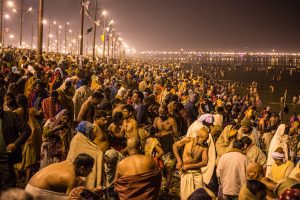 Along the frigid rivers of North America, First Nations women of various tribes and traditions gather to play with birch sticks, with hand-held drums, to recommence the Nibi Wabo,[7] a Water Ceremony, Walk of gratitude, and Prayer for pure, clean waters, which had languished in the shadows of time for over a century, but much needed now.
Along the frigid rivers of North America, First Nations women of various tribes and traditions gather to play with birch sticks, with hand-held drums, to recommence the Nibi Wabo,[7] a Water Ceremony, Walk of gratitude, and Prayer for pure, clean waters, which had languished in the shadows of time for over a century, but much needed now.
Water is fluid. Pilgrimages are, too, in their continuity. From antiquity, people have gathered, commemorating times of faith, of sacrifice or victory, of rains, renewal, cleansing, of hope, across cultures, across religions, celebrating specific links to the life force which flows through us all. So many involve the sacrifice or heroism of one iconic figure, inspiring the coalescence of numberless millions, who leave their forests and mountains, their rural farms and urban city dwellings, to participate, to become imbued with a spirit simultaneously intensely individualistic, and overwhelmingly universal.
Water is fluid. Pilgrimages are, too, in their continuity. From antiquity, people have gathered, commemorating times of faith, of sacrifice or victory, of rains, renewal, cleansing, of hope, across cultures, across religions, celebrating specific links to the life force which flows through us all.
People are drawn to water; have been, throughout history. From my earliest memories of trying to run into balmy summer seas to winter swims surrounded by Leidy’s comb jellies[8] seeking warmer shoreline waters (because my great- grandmother and a great-aunt said “we’ve always swum here”), to more recent memories of dipping into salty, land-locked Lake Issyk Kul[9] or frozen glacial streams in Kyrgyzstan, I run to the water, whenever I can. Sometimes my water experiences coincide with festivals, observances, or pilgrimages, which I try to comprehend, since these histories affect us all. And water courses through many of them.
grandmother and a great-aunt said “we’ve always swum here”), to more recent memories of dipping into salty, land-locked Lake Issyk Kul[9] or frozen glacial streams in Kyrgyzstan, I run to the water, whenever I can. Sometimes my water experiences coincide with festivals, observances, or pilgrimages, which I try to comprehend, since these histories affect us all. And water courses through many of them.
Each winter, close to the Kyrgyz capital of Bishkek,[10] and around the globe, [11] Orthodox Christians can dip in openings cut in ice-covered lakes, rivers, or glacial streams, in celebration of the Epiphany—an observance which has been echoed in “polar bear” immersions in winter waters around the world (by faithful and non-faithful alike), as well as in the more temperate waters of the River Jordan,[12] where John the Baptist is believed to have baptized Jesus.
Similarly, to the pathways of the waters continually flowing over and through our planet, humans continue to be diverted, redirected, and (one hopes) to evolve. Interfaith scholars look at historic locations[13] like the River Jordan, imbued with millennia of ancient Judaic, Christian, Islamic, Bedouin[14] and other history and traditions.
Water unites us in life, and in death. In Nepal, for example, the holy waters of the Bagmati River[15] purify the body of the deceased before cremation, and, after the funeral pyre is lighted, relatives of the deceased process to the river, bathing or sprinkling themselves with the waters, in an act of physical and spiritual purification.
Water unites us in life, and in death.
Like water, peoples merge, change, generate new possibilities, open new vistas. The crowds of millions of people, moving towards the confluence of waters at the Kumbh Mela, resemble the surface waves on water blown by the wind. The trials and tales of human history ebb and flow, like tides. Now, as humanity stands at the brink of the Anthropocene,[16] where the Earth’s geology, hydrologic, and ecosystems are being altered by the sheer numbers of human beings populating our planet, our ties to the ancients, who waded in clear waters to purify themselves, become poignant reminders of all we have been, of all we are now — and the tsunami of our global impact now forces many to question our habits, our faiths, and our futures.
Have humans irreversibly altered the planet we inhabit? The waters, the soils, many species of life preceded the advent of humankind; perhaps it is the Earth and its ancient forces which will survive, and humans who must either participate in their reformation or perish.
We look to the stars, and wonder if life exists on other planets, in other realms. Our Earth, many planets and solar systems are surrounded by Van Allen Belts,[17]zones of charged particles,[18] with energy which may originate from solar winds, and are then captured and held closely by each planet’s magnetic fields. Movement through the energy fields, changes wrought by the proximity of the moon, the orbits of planets, our own orbit around the sun and its magnetic storms, create waves along and through the plasma, much as waves alter the surface and flow of water on Earth.
The Earth is, daily, bathed in the plasma of the Van Allen Belts— as all which enters our atmosphere has been — as all which we send rocketing ever farther into the reaches of space must be. In effect, all we do is bathed by the simple fact of living on a planetary system which has existed longer than all the lives of our species put together.
During these weeks, we watch the panoply of the Kumbh Mela unfold, repeating centuries of tradition in a pageant of surging life simultaneously ancient and new. The aged are led to the waters, carrying the weight of generations on their frail shoulders. The young rush in joyously, wings on their feet, smiles and gladness uplifting their hearts. Royalty of nation, royalty of popular culture, royalty of industry, politicians, philosophers, sages and paupers dip into the waters which lap, tirelessly, upon shores which, in a blink, will once again revert to the mundane, the incognito aspect of the everyday.
…we watch the panoply of the Kumbh Mela unfold, repeating centuries of tradition in a pageant of surging life simultaneously ancient and new.
What will we all have learned, we, humankind, with all our hopes and fears, with the certitude that a higher One, or Oneness exists still warring with the absolute assurance that there is no god, no God? We must learn, for the world is at the cusp of a new age. Like the infants and children who press designs, pat castles and dream dreams along the sandy shores of the Ganga, under the watchful eyes of their families, we enjoy the sights and sounds and smells of the Festival, and we ignore the reality awaiting us just outside.
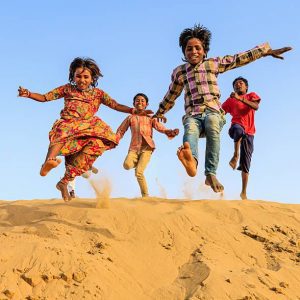 We cleanse our present selves, but we must address the thirst of our unborn generations. There is a balance, and a vastness, to our Earth, our solar system, and the Universe which we, so young a species, with such hubris, have only glimpsed. We wade in waters we can touch, taste, and see, and aspire to faith and a higher state of being. Perhaps nothing is, ever, lost. Perhaps we are cleansing our selves, our souls, our generations past and future. The waters of the Ganga, the Yamuna and the Saraswati flow on; the Kumbh Mela proceeds.
We cleanse our present selves, but we must address the thirst of our unborn generations. There is a balance, and a vastness, to our Earth, our solar system, and the Universe which we, so young a species, with such hubris, have only glimpsed. We wade in waters we can touch, taste, and see, and aspire to faith and a higher state of being. Perhaps nothing is, ever, lost. Perhaps we are cleansing our selves, our souls, our generations past and future. The waters of the Ganga, the Yamuna and the Saraswati flow on; the Kumbh Mela proceeds.
All organic creatures on this planet we share need water, in some form, to survive. Water fills our cells, drives our thirsts, informs our very existence. Across the ages, water flows in us, through us, around us … despite us.
Next year, our tumultuous past being any indication, some of our human tribe will have passed beyond our reach to unknown realms, some new lives will be born. Deeds, great, small, criminal, inconsequential, will color our shared history. The sun will rise, and the moon take the skies at the sun’s setting. The thoughts of hundreds of millions will turn again to the Kumbh Mela, the largest peaceful pilgrimage known to man. Serendipitously, the waters of the mighty rivers and oceans of our Earth will still be flowing.
And what will we be doing? Will we learn to work together, to coexist in faith, in requirement, in understanding? Will we help preserve the waters we so blithely pollute with our excesses?
When preparations for the next festivals, ceremonies and baptisms of water again mark our calendars, where will we be?
[1] https://ich.unesco.org/en/RL/kumbh-mela-01258
[2] http://www.bangkok.com/whats-on-events/loy-krathong.htm
[3] https://kohsamui.kohlidays.com/loy-kratong/
[4] https://en.wikipedia.org/wiki/Loi_Krathong
[5] http://eastafricaschoolserver.org/Wikipedia/wp/m/Mekong.htm
[6] https://www.patana.ac.th/Events/Loykratong/Loy_Kratong.htm
[7] https://insectamonarca.wordpress.com/2010/01/29/nibi-wabo-water-ceremony/
[8]https://www.ct.gov/deep/lib/deep/water/lis_water_quality/hypoxia/GelatinousPlanktonLong_Island_Sound.pdf
[9] https://en.wikipedia.org/wiki/Issyk-Kul
[10] https://www.efe.com/efe/english/life/orthodox-christians-in-kyrgyzstan-brave-frigid-temperatures-to-mark-
epiphany/50000263-3871994
[11] https://www.dailymail.co.uk/news/article-4136980/Orthodox-Christians-bathe-icy-waters-mark-Epiphany.html
[12] https://www.timesofisrael.com/photo-essay-epiphany-in-the-jordan-river/
[13] https://www.interfaithsustain.com/an-interfaith-look-at-the-jordan-river/
[14] https://en.wikipedia.org/wiki/Bedouin
[15] https://mysendoff.com/2011/06/nepal-funeral-traditions/
[16] http://www.anthropocene.info/
[17] https://en.wikipedia.org/wiki/Van_Allen_radiation_belt
[18] http://adsabs.harvard.edu/full/1962JPSJS..17B.148K
©Michele Baron
Photos by the author and from the Internet

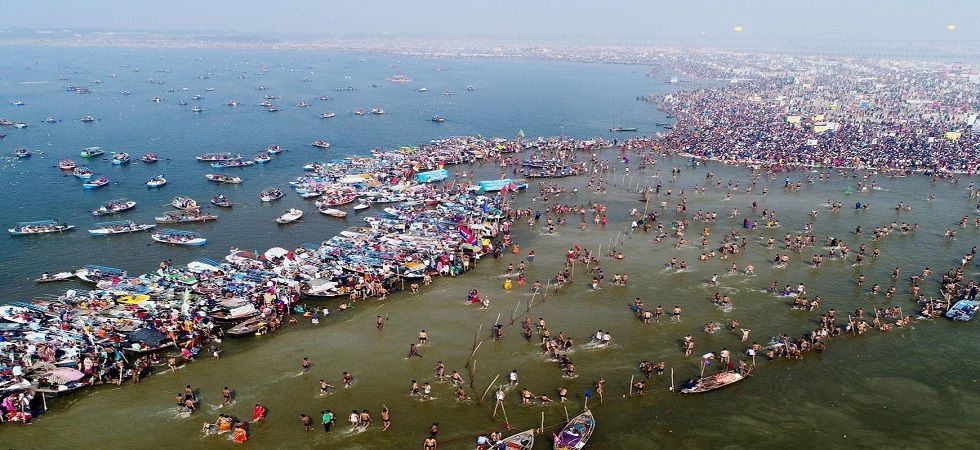

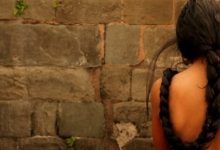

 By
By

 By
By
Arm chair journalism at its best
Arm chair journalism at its best, connects cultures through traditional water festivals.👍
Very well written, raising questions, and imparting knowledge.
Such a beautiful narration of the auspicious Kumbh Mela which many Indians including me are not fully aware of. Beautiful. Thank you.
Such a beautiful narration of Kumbh Mela which many Indians including me are unaware of .
Thoroughly enjoyed reading
A very informative and elaborate ink about Kumbha Mela . Even many Indians are unaware of the details . Indeed a happy read